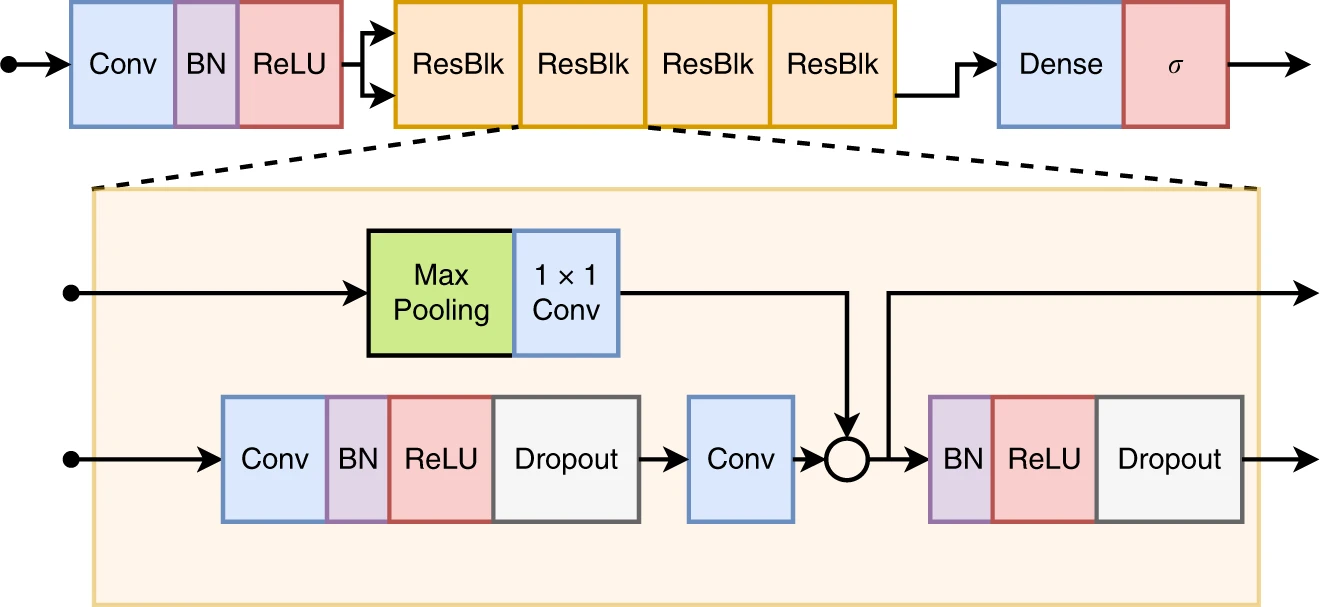Downloads: 1
Diff of
/README.md
[000000]
..
[c1a411]
Switch to side-by-side view
--- a +++ b/README.md @@ -0,0 +1,123 @@ +# Automatic ECG diagnosis using a deep neural network +Scripts and modules for training and testing deep neural networks for ECG automatic classification. +Companion code to the paper "Automatic diagnosis of the 12-lead ECG using a deep neural network". + https://www.nature.com/articles/s41467-020-15432-4. + +-------- + +Citation: +``` +Ribeiro, A.H., Ribeiro, M.H., Paixão, G.M.M. et al. Automatic diagnosis of the 12-lead ECG using a deep neural network. +Nat Commun 11, 1760 (2020). https://doi.org/10.1038/s41467-020-15432-4 +``` + +Bibtex: +``` +@article{ribeiro_automatic_2020, + title = {Automatic Diagnosis of the 12-Lead {{ECG}} Using a Deep Neural Network}, + author = {Ribeiro, Ant{\^o}nio H. and Ribeiro, Manoel Horta and Paix{\~a}o, Gabriela M. M. and Oliveira, Derick M. and Gomes, Paulo R. and Canazart, J{\'e}ssica A. and Ferreira, Milton P. S. and Andersson, Carl R. and Macfarlane, Peter W. and Meira Jr., Wagner and Sch{\"o}n, Thomas B. and Ribeiro, Antonio Luiz P.}, + year = {2020}, + volume = {11}, + pages = {1760}, + doi = {https://doi.org/10.1038/s41467-020-15432-4}, + journal = {Nature Communications}, + number = {1} +} +``` +----- + +## Requirements + +This code was tested on Python 3 with Tensorflow `2.2`. There is an older branch ([`tensorflow-v1`](https://github.com/antonior92/automatic-ecg-diagnosis/tree/tensorflow-v1)) that +contain the code implementation for Tensorflow `1.15`. + +**For pytorch users:** If you are interested in a pytorch implementation, take a look in the repository: https://github.com/antonior92/ecg-age-prediction. +There we provide a implementation in PyTorch of the same resnet-based model. The problem there is the age prediction from the ECG, nontheless simple modifications should suffice for dealing with abnormality classification. + +## Model + +The model used in the paper is a residual neural. The neural network architecture implementation in Keras is available in ``model.py``. To print a summary of the model layers run: +```bash +$ python model.py +``` + + + +The model receives an input tensor with dimension `(N, 4096, 12)`, and returns an output tensor with dimension `(N, 6)`, +for which `N` is the batch size. + +The model can be trained using the script `train.py`. Alternatively, +pre-trained weighs for the models described in the paper are also +available in: https://doi.org/10.5281/zenodo.3625017. Or in the mirror dropbox +link [here](https://www.dropbox.com/s/5ar6j8u9v9a0rmh/model.zip?dl=0). +Using the command line, the weights can be downloaded using +``` +wget https://www.dropbox.com/s/5ar6j8u9v9a0rmh/model.zip?dl=0 -O model.zip +unzip model.zip +``` + +- **input**: `shape = (N, 4096, 12)`. The input tensor should contain the `4096` points of the ECG tracings +sampled at `400Hz` (i.e., a signal of approximately 10 seconds). Both in the training and in the test set, when the +signal was not long enough, we filled the signal with zeros, so 4096 points were attained. The last dimension of the +tensor contains points of the 12 different leads. The leads are ordered in the following order: +`{DI, DII, DIII, AVR, AVL, AVF, V1, V2, V3, V4, V5, V6}`. All signal are represented as +32 bits floating point numbers at the scale 1e-4V: so if the signal is in V it should be multiplied by +1000 before feeding it to the neural network model. + + +- **output**: `shape = (N, 6)`. Each entry contains a probability between 0 and 1, and can be understood as the +probability of a given abnormality to be present. The abnormalities it predicts are **(in that order)**: 1st degree AV block(1dAVb), + right bundle branch block (RBBB), left bundle branch block (LBBB), sinus bradycardia (SB), atrial fibrillation (AF), +sinus tachycardia (ST). The abnormalities are not mutually exclusive, so the probabilities do not necessarily +sum to one. + + + +## Datasets + +- The testing dataset described in the paper can be downloaded in: +[doi: 10.5281/zenodo.3625006](https://doi.org/10.5281/zenodo.3625006). There is also a mirror +dropbox link [here](https://www.dropbox.com/s/p3vd3plcbu9sf1o/data.zip?dl=0). +Using the command line: +``` +wget https://www.dropbox.com/s/p3vd3plcbu9sf1o/data.zip?dl=0 -O data.zip +unzip data.zip +``` +- Part of the training data (the CODE-15\% dataset) is openly available in: [doi: 10.5281/zenodo.4916206 ](https://doi.org/10.5281/zenodo.4916206). +- The full CODE dataset that was used for training is available upon request for research purposes: [doi: 10.17044/scilifelab.15169716](https://doi.org/10.17044/scilifelab.15169716) + +## Scripts + +- ``train.py``: Script for training the neural network. To train the neural network run: +```bash +$ python train.py PATH_TO_HDF5 PATH_TO_CSV +``` +Pre-trained models obtained using such script can be downloaded from [here](https://doi.org/10.5281/zenodo.3625017) + + +- ``predict.py``: Script for generating the neural network predictions on a given dataset. +```bash +$ python predict.py PATH_TO_HDF5_ECG_TRACINGS PATH_TO_MODEL --ouput_file PATH_TO_OUTPUT_FILE +``` +The folder `./dnn_predicts` contain the output obtained by applying this script to the models available in +[here](https://doi.org/10.5281/zenodo.3625017) to make the predictions on tracings from +[this test dataset](https://doi.org/10.5281/zenodo.3625006). + + +- ``generate_figures_and_tables.py``: Generate figures and tables from the paper "Automatic Diagnosis o +the Short-Duration12-Lead ECG using a Deep Neural Network". Make sure to execute the script from the root folder, +so all relative paths are correct. So first run: +``` +$ cd /path/to/automatic-ecg-diagnosis +``` +Then the script + ```bash +$ python generate_figures_and_tables.py +``` +It should generate the tables and figure in the folder `outputs/` + +- ``model.py``: Auxiliary module that defines the architecture of the deep neural network. +To print a summary of the model layers run: +```bash +$ python model.py +```

 Datasets
Datasets
 Models
Models